Search Result
Results for "
nAChR inhibitor
" in MedChemExpress (MCE) Product Catalog:
3
Isotope-Labeled Compounds
| Cat. No. |
Product Name |
Target |
Research Areas |
Chemical Structure |
-
- HY-152170
-
|
|
nAChR
|
Neurological Disease
|
|
bPiDI is a novel selective α6β2 nicotinic receptor antagonist. bPiDI inhibits nicotine-evoked striatal dopamine (DA) release through an interaction with α6β2-containing nAChRs .
|
-
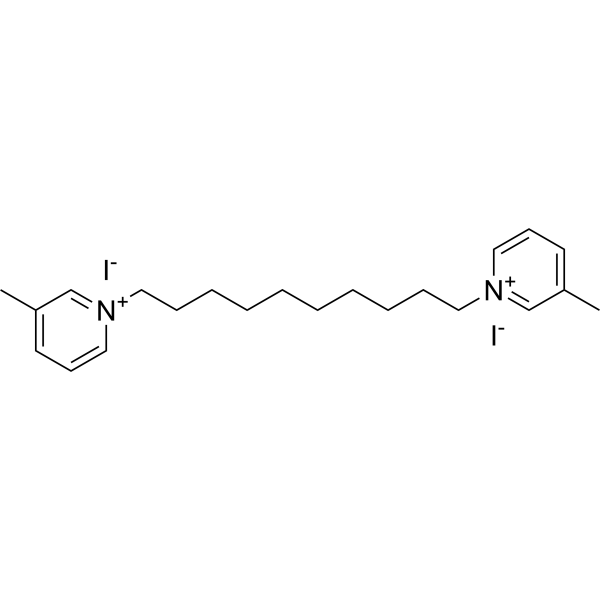
-
- HY-B0118A
-
|
ORG NC 45
|
nAChR
|
Neurological Disease
Cancer
|
|
Vecuronium (ORG NC 45) bromide is a non-depolarizing neuromuscular blocking agent that also acts as a nicotinic acetylcholine receptor (nAChR) inhibitor, a muscle relaxant, and can be used for pre-surgical anesthesia .
|
-

-
- HY-N12511
-
|
|
nAChR
|
Neurological Disease
|
|
Aristoquinoline (Compound 1) is an alkaloid can be isolated from Aristotelia chilensis. Aristoquinoline has α3β4 nAChR inhibitory activity .
|
-
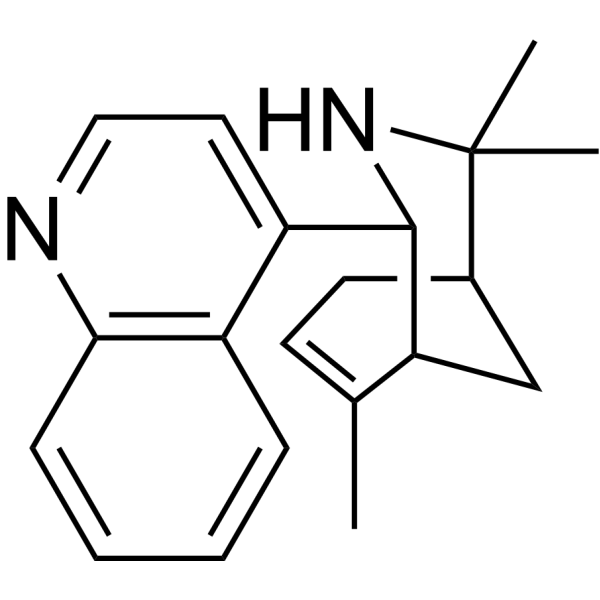
-
- HY-107669
-
|
|
nAChR
|
Neurological Disease
|
|
nAChR-IN-1 (hydrochloride) is a tetramethylpiperidine heptanoate, a selective nicotinic acetylcholine receptor (nAChR) inhibitor that inhibits nAChRs lacking α5, α6, or β3 subunits. nAChR-IN-1 has the effect of preventing nerve disorder, can be used for nicotinic acetylcholine receptor dysfunction or neurological disorders research .
|
-
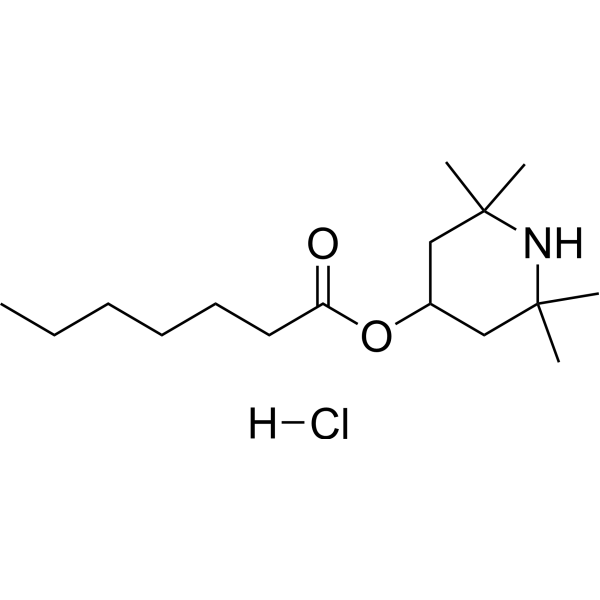
-
- HY-P5823
-
|
|
nAChR
|
Neurological Disease
|
|
Azemiopsin is a potent nicotinic acetylcholine receptor (nAChR) inhibitor with IC50s of 0.18 μM and 22 μM against T. californica nAChR and human α7 nAChR, respectively. Azemiopsin blocks acetylcholine-induced currents in Xenopus oocytes heterologously expressing human muscle-type nAChR .
|
-

-
- HY-151129
-
|
|
nAChR
|
Neurological Disease
|
|
nAChR-IN-1 (2,2,6,6-Tetramethylpiperidin-4-yl heptanoate) is a tetramethylpiperidine heptanoate, a selective nicotinic acetylcholine receptor (nAChR) inhibitor that inhibits nAChRs lacking α5, α6, or β3 subunits. nAChR-IN-1 has the effect of preventing nerve disorder, can be used for nicotinic acetylcholine receptor dysfunction or neurological disorders research .
|
-
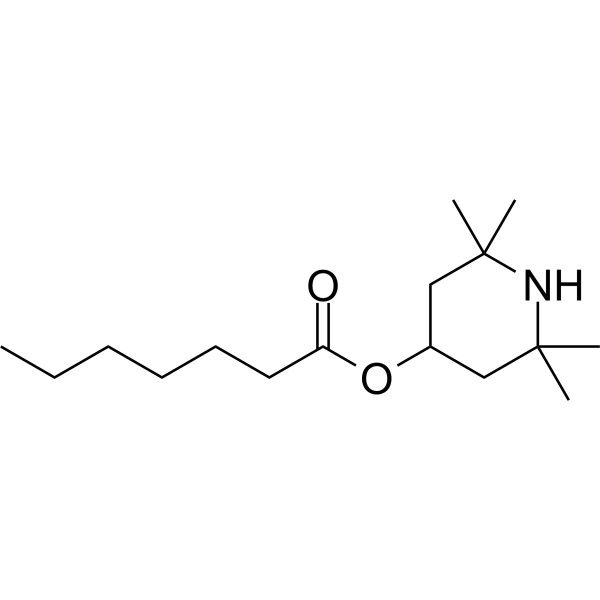
-
- HY-14316A
-
|
Ebanicline dihydrochloride; ABT-594 dihydrochloride
|
nAChR
|
Neurological Disease
|
|
Tebanicline dihydrochloride (Ebanicline dihydrochloride) is a nAChR modulator with potent, orally effective analgesic activity. It inhibits the binding of cytisine to α4β2 neuronal nAChRs with a Ki of 37 pM .
|
-
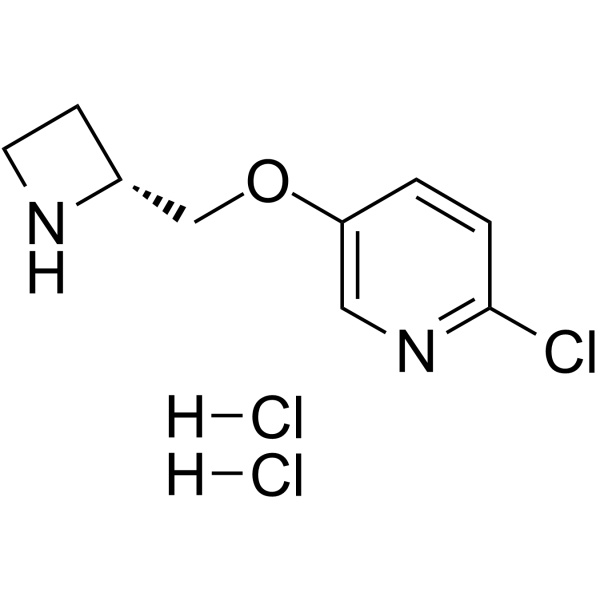
-
- HY-14316B
-
|
Ebanicline hydrochloride; ABT-594 hydrochloride
|
nAChR
|
Neurological Disease
|
|
Tebanicline hydrochloride (Ebanicline hydrochloride) is a nAChR modulator with potent, orally effective analgesic activity. Tebanicline hydrochloride inhibits the binding of cytisine to α4β2 neuronal nAChRs with a Ki of 37 pM .
|
-

-
- HY-157958
-
|
|
nAChR
|
Neurological Disease
|
|
α7 nAChR modulator-3 (Compound 6p) is a α7 nAChR positive allosteric Modulator with a IC50 value of 1.3 μM. α7 nAChR Modulator-3 can be used to inhibit auditory gating defects in a mouse schizophrenic model .
|
-
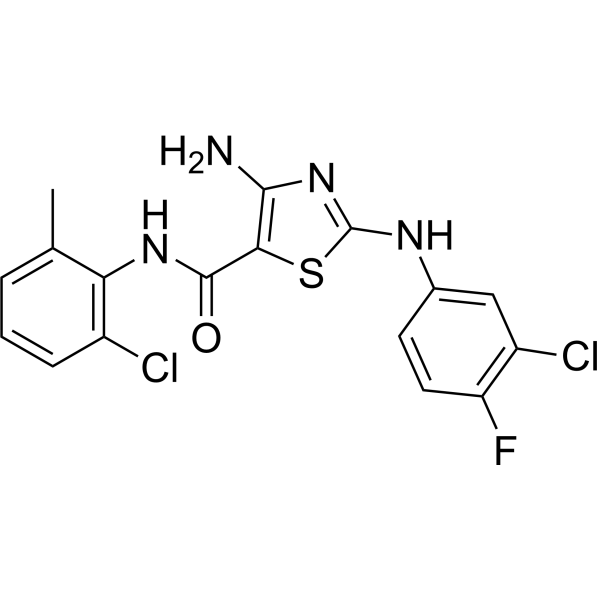
-
- HY-107674
-
|
|
nAChR
|
Neurological Disease
|
|
bPiDDB is a potent nAChR antagonist. bPiDDB potently (IC50=2 nM) inhibits nicotine-evoked striatal dopamine (DA) release through an interaction with α6β2-containing nAChRs .
|
-

-
- HY-146066
-
|
|
nAChR
JAK
STAT
NO Synthase
|
Inflammation/Immunology
|
|
α7 nAchR-JAK2-STAT3 agonist 1 is a potent α7 nAchR-JAK2-STAT3 agonist, with an IC50 value of 0.32 μM for nitric oxide (NO). α7 nAchR-JAK2-STAT3 agonist 1 effectively suppresses the expression of iNOS, IL-1β, and IL-6 in murine RAW264.7 macrophages. α7 nAchR-JAK2-STAT3 agonist 1 can inhibit LPS-induced NO release, NF-κB activation and cytokine production. α7 nAchR-JAK2-STAT3 can be used for researching sepsis .
|
-
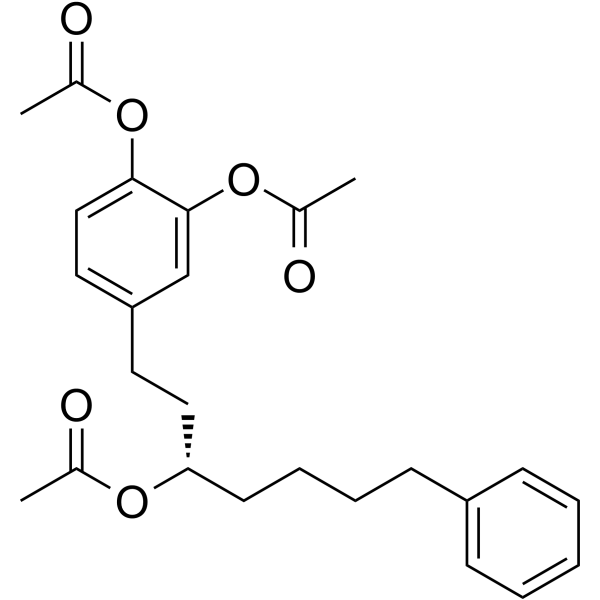
-
- HY-B0282S
-
|
ACh-d4 (chloride)
|
nAChR
Calcium Channel
Endogenous Metabolite
|
Neurological Disease
Cancer
|
|
Acetylcholine-d4 (chloride) is the deuterium labeled Acetylcholine chloride. Acetylcholine chloride (ACh chloride), a neurotransmitter, is a potent cholinergic agonist. Acetylcholine chloride is a modulator of the activity of dopaminergic (DAergic) neurons through the stimulation of nicotinic acetylcholine receptors (nAChRs)[1][2]. Acetylcholine chloride inhibits p53 mutant peptide aggregation in vitro[5].
|
-

-
- HY-B0282S1
-
|
ACh-d9(chloride)
|
nAChR
Calcium Channel
Endogenous Metabolite
|
Neurological Disease
Cancer
|
|
Acetylcholine-d9 (chloride) is the deuterium labeled Acetylcholine chloride. Acetylcholine chloride (ACh chloride), a neurotransmitter, is a potent cholinergic agonist. Acetylcholine chloride is a modulator of the activity of dopaminergic (DAergic) neurons through the stimulation of nicotinic acetylcholine receptors (nAChRs)[1][2]. Acetylcholine chloride inhibits p53 mutant peptide aggregation in vitro[5].
|
-

-
- HY-W795027
-
-

-
- HY-13780
-
|
Vincaleukoblastine sulfate salt
|
Microtubule/Tubulin
Autophagy
|
Cancer
|
|
Vinblastine sulfate is a cytotoxic alkaloid used against various cancer types. Vinblastine sulfate inhibits the formation of microtubule and suppresses nAChR with an IC50 of 8.9 μM.
|
-
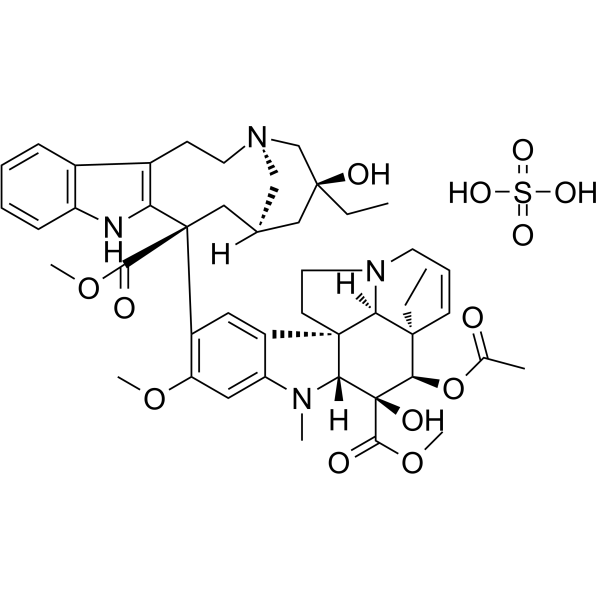
-
- HY-P5844
-
|
|
nAChR
|
Neurological Disease
|
|
α-Conotoxin AuIA is a potent and selective α3β4 n-nAChR inhibitor. α-Conotoxin AuIA is a α-conotoxin that can be isolated from Conus aulicus .
|
-
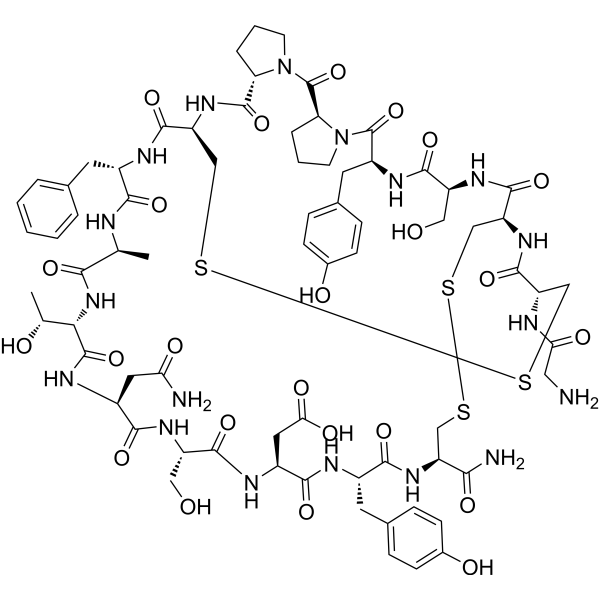
-
- HY-B0282
-
|
ACh chloride
|
nAChR
Calcium Channel
Endogenous Metabolite
|
Neurological Disease
Cancer
|
|
Acetylcholine chloride (ACh chloride), a neurotransmitter, is a potent cholinergic agonist. Acetylcholine chloride is a modulator of the activity of dopaminergic (DAergic) neurons through the stimulation of nicotinic acetylcholine receptors (nAChRs) . Acetylcholine chloride inhibits p53 mutant peptide aggregation in vitro .
|
-
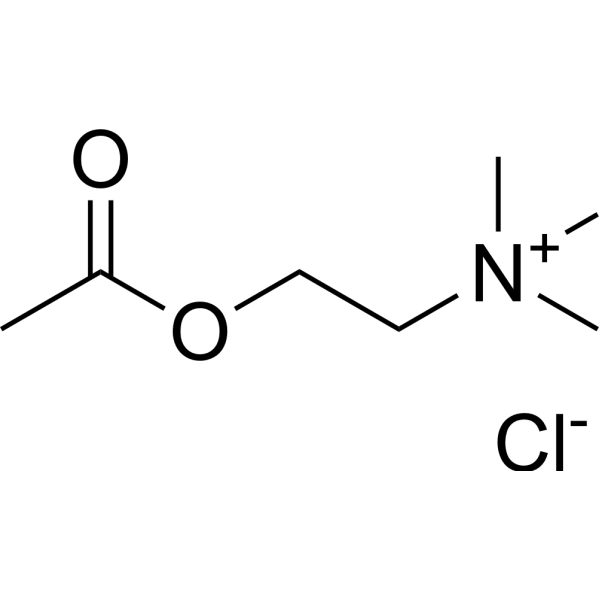
-
- HY-149483
-
|
|
nAChR
|
Neurological Disease
|
|
CVN417 is an orally active α6 subunit-containing nAChR antagonist, modulating phasic dopaminergic neurotransmission in an impulse-dependent manner. CVN417 inhibits Ca(2+) effluents mediated by nAChR subunits with IC50s of 0.086 μM (α6), 2.56 μM (α3) and 0.657 μM (α4), respectively. CVN417 attenuates resting tremor in Rodent models, displays the potential to improve movement dysfunction, in conditions such as Parkinson's disease .
|
-
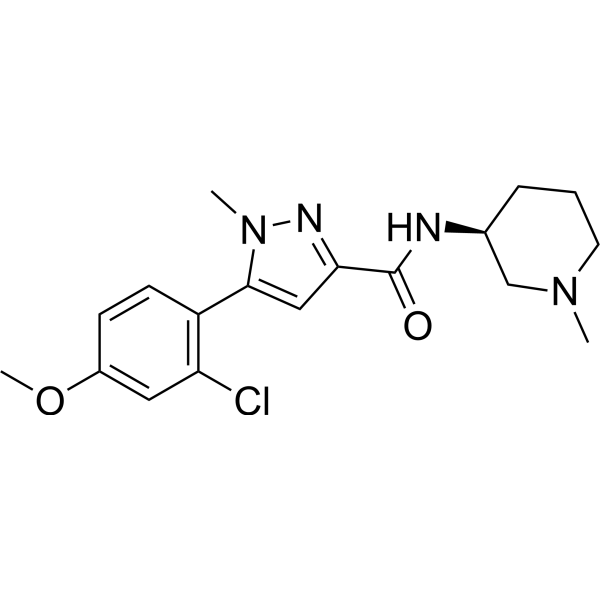
-
- HY-B1700A
-
|
|
nAChR
|
Neurological Disease
|
|
Mivacurium dichloride is a benzylisoquinoline derivative and is a short-acting non-depolarizing neuromuscular blocking agent and skeletal muscle relaxant. Mivacurium dichloride couples with the nAChR to reduce or inhibit the depolarizing effect of acetylcholine on the terminal disc of the muscle cell .
|
-
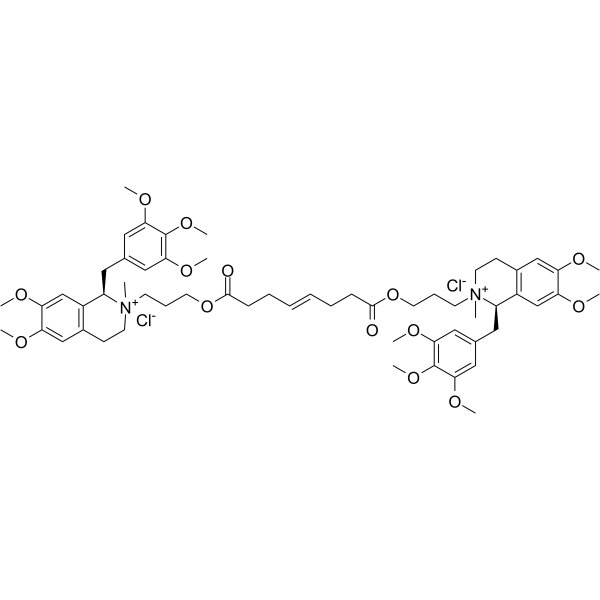
-
- HY-P1271
-
|
|
nAChR
|
Cardiovascular Disease
|
|
Catestatin is a 21-amino acid residue, cationic and hydrophobic peptide. Catestatin is an endogenous peptide that regulates cardiac function and blood pressure . Catestatin is a non-competitive nicotinic antagonist acting through nicotinic acetylcholine receptors (nAChRs) to inhibit catecholamine release .
|
-

-
- HY-P3653
-
|
|
mAChR
nAChR
|
Neurological Disease
|
|
α-Conotoxin M I is a potent and selective inhibitor of mAChR and α1β1γδ nAChR, but has no effect on nicotine-stimulated dopamine release. α-Conotoxins are small, disulfide-rich peptides that competitively inhibit muscle and neuronal nicotinic AChRs .
|
-
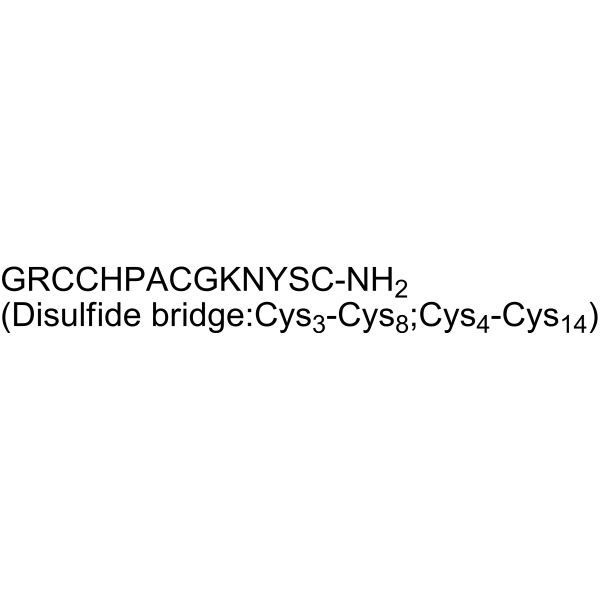
-
- HY-P5147
-
|
|
nAChR
|
Neurological Disease
|
|
α-Conotoxin GID is a paralytic peptide neurotoxin and a selective antagonist of nAChR, with IC50s of 5 nM (α7), 3 nM (α3β2), 150 nM (α4β2), respectively. α-Conotoxin GID is small disulfide-rich peptide, with potential to inhibit chronic pain. α-Conotoxin GID contains a C-terminal carboxylate, thus substitution with a C-terminal carboxamide results in loss of α4β2 nAChR. α-Conotoxin GID can be isolated from the Conus species .
|
-
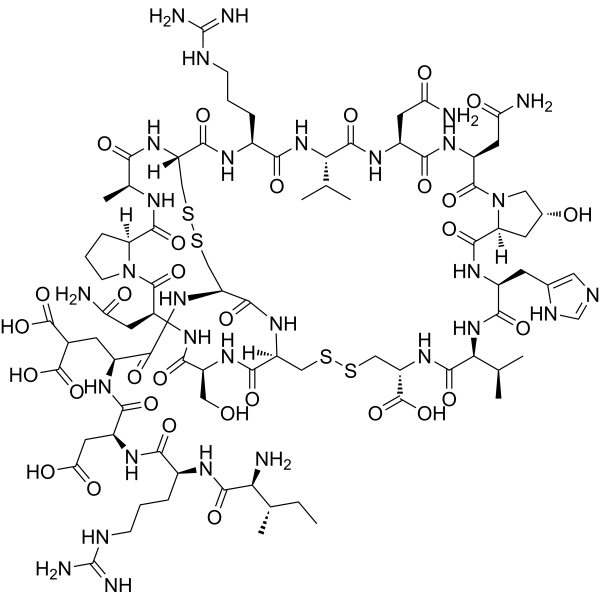
-
- HY-P1271A
-
|
|
nAChR
|
Cardiovascular Disease
|
|
Catestatin TFA is a 21-amino acid residue, cationic and hydrophobic peptide. Catestatin TFA is an endogenous peptide that regulates cardiac function and blood pressure . Catestatin TFA is a non-competitive nicotinic antagonist acting through nicotinic acetylcholine receptors (nAChRs) to inhibit catecholamine release .
|
-
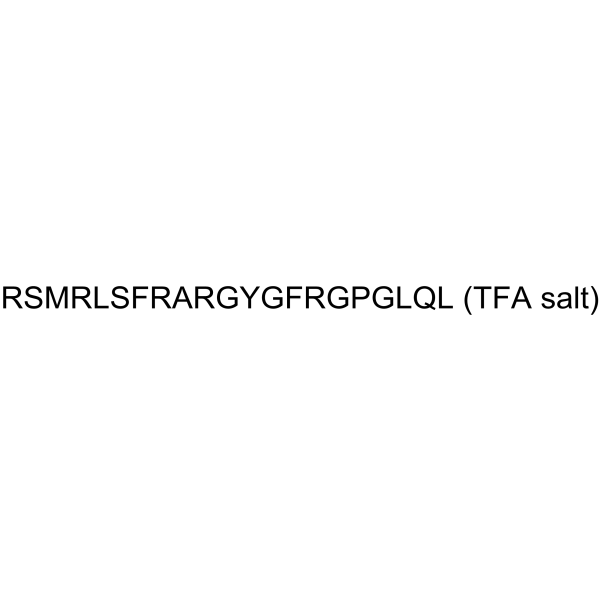
-
- HY-125777A
-
|
|
nAChR
|
Neurological Disease
|
|
α-Conotoxin Vc1.1 TFA is a disulfide-bonded peptide isolated from Conus victoriae and is a selective nAChR antagonist. α-Conotoxin Vc1.1 TFA inhibits α3α5β2, α3β2 and α3β4 with IC50s of 7.2 μM, 7.3 μM and 4.2 μM, respectively, and has less inhibitory effect on other nAChR subtypes. α-Conotoxin Vc1.1 TFA has the potential for neuropathic pain reserach .
|
-
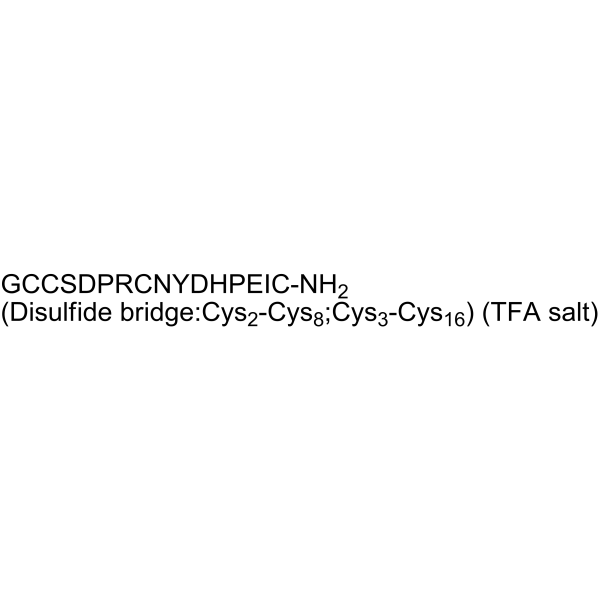
-
- HY-P5146
-
-
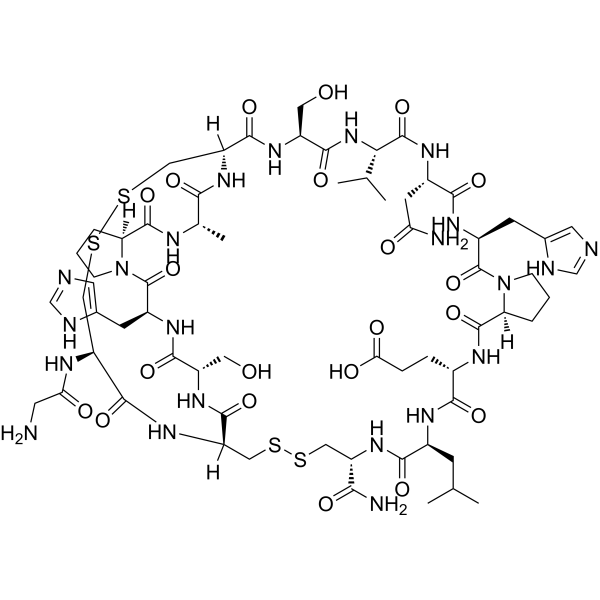
-
- HY-P1266
-
|
|
nAChR
|
Neurological Disease
|
|
α-Conotoxin EI is a selective nicotinic acetylcholine α1β1γδ receptor (nAChR) antagonist (IC50=187 nM) and an α3β4 receptor inhibitor. α-Conotoxin EI can block muscle and ganglionic receptors .
|
-
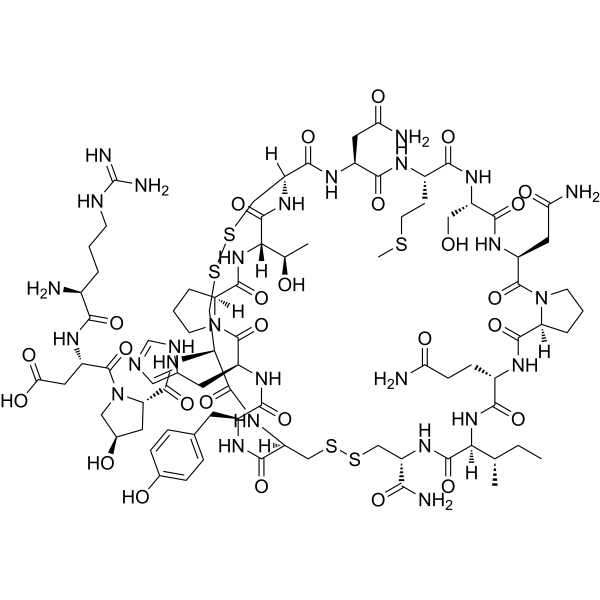
-
- HY-N10132
-
|
|
nAChR
|
Infection
Neurological Disease
|
|
Microgrewiapine A is an antagonist of nAChR. Microgrewiapine A inhibits hα4β2 and hα3β4 activity with 60% and 70% inhibition, respectively. Microgrewiapine A has selective cytotoxic against HT-29 human colon cancer cells with an IC50 of 6.8 μM .
|
-

-
- HY-105118A
-
|
CGS-9343B; KW 5617
|
Calmodulin
|
Neurological Disease
Metabolic Disease
Inflammation/Immunology
|
|
Zaldaride maleate (CGS-9343B) is a potent, orally active and selective inhibitor of calmodulin. Zaldaride maleate (CGS-9343B) inhibits CaM (calmodulin)-stimulated cAMP phosphodiesterase activity, with an IC50 of 3.3 nM . Zaldaride maleate (CGS-9343B) prevents estrogen-induced transcription activation by ER, reversibly blocks voltage-activated Na +, Ca 2+ and K + currents in PC12 cells and inhibits nAChR .
|
-

-
- HY-B0379A
-
|
|
nAChR
|
Neurological Disease
|
|
Adiphenine hydrochloride is a non-competitive inhibitor of nicotinic acetylcholine receptor (nAChR), with an IC50s of 1.9, 1.8, 3.7, and 6.3 µM for α1, α3β4, α4β2, and α4β4, respectively. Adiphenine hydrochloride has anticonvulsant effects .
|
-
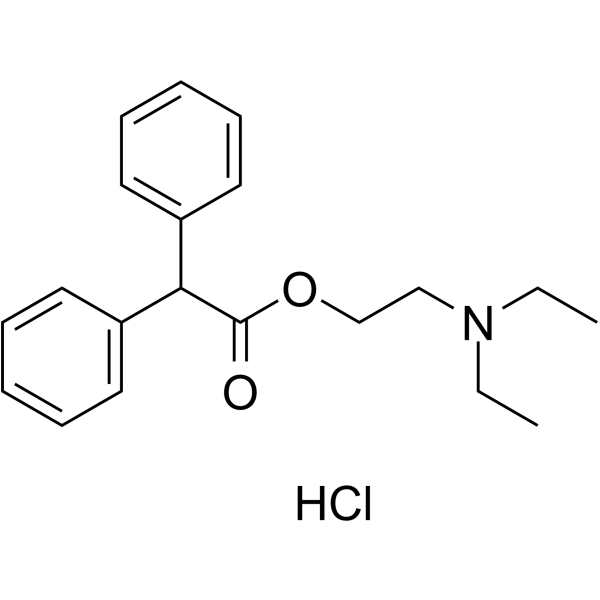
-
- HY-126047B
-
|
|
NF-κB
Amyloid-β
nAChR
|
Neurological Disease
Inflammation/Immunology
|
|
(R)-(+)-Anatabine is an less active R-enantiomer of Anatabine. Anatabine is a potent α4β2 nAChR agonist . Anatabine inhibits NF-κB activation lower amyloid-β (Aβ) production by preventing the β-cleavage of amyloid precursor protein (APP). Anatabine has anti-inflammatory effects and has the potential for neurodegenerative disorders treatment .
|
-
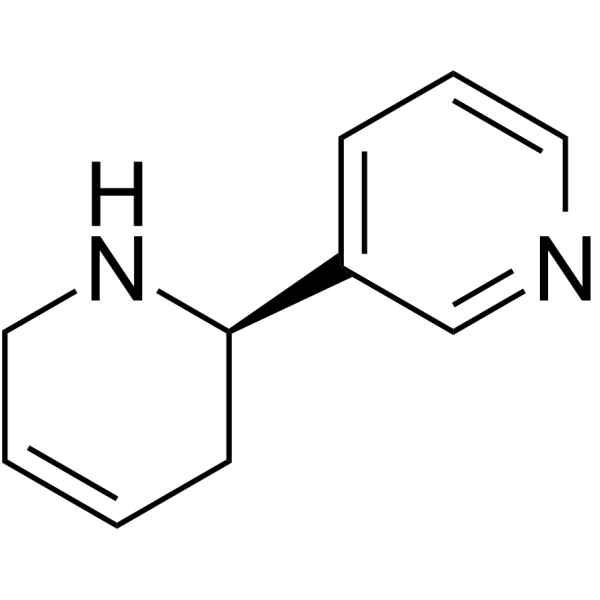
-
- HY-A0009
-
|
Galantamine hydrobromide
|
Cholinesterase (ChE)
nAChR
|
Neurological Disease
|
|
Galanthamine hydrobromide (Galantamine hydrobromide) is a selective, reversible, competitive, alkaloid AChE inhibitor, with an IC50 of 0.35 µM. Galanthamine hydrobromide is a potent allosteric potentiating ligand (APL) of human α3β4, α4β2, α6β4 nicotinic receptors ( nAChRs). Galanthamine hydrobromide is developed for the research of Alzheimer's disease (AD) .
|
-

-
- HY-19918A
-
|
|
NF-κB
Amyloid-β
nAChR
|
Neurological Disease
Inflammation/Immunology
|
|
Anatabine dicitrate is a tobacco alkaloid that can cross the blood-brain barrier. Anatabine dicitrate is a potent α4β2 nAChR agonist. Anatabine dicitrate inhibits NF-κB activation lower amyloid-β (Aβ) production by preventing the β-cleavage of amyloid precursor protein (APP). Anatabine dicitrate has anti-inflammatory effects and has the potential for neurodegenerative disorders treatment .
|
-
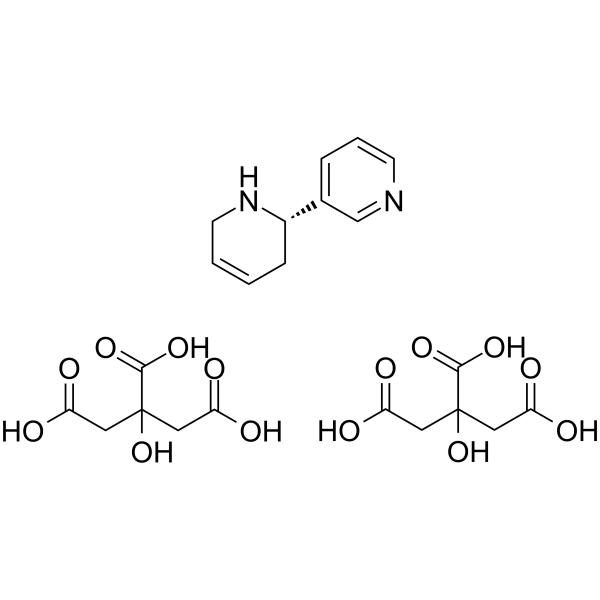
-
- HY-A0009S
-
|
Galantamine-d3 hydrobromide
|
Isotope-Labeled Compounds
Cholinesterase (ChE)
nAChR
|
Neurological Disease
|
|
Galanthamine-d3 (hydrobromide) is deuterium labeled Galanthamine (hydrobromide). Galanthamine hydrobromide (Galantamine hydrobromide) is a selective, reversible, competitive, alkaloid AChE inhibitor, with an IC50 of 0.35 µM. Galanthamine hydrobromide is a potent allosteric potentiating ligand (APL) of human α3β4, α4β2, α6β4 nicotinic receptors ( nAChRs). Galanthamine hydrobromide is developed for the research of Alzheimer's disease (AD)[1][2][3].
|
-

-
- HY-A0009R
-
|
Galantamine hydrobromide (Standard)
|
nAChR
Cholinesterase (ChE)
|
Neurological Disease
|
|
Galanthamine (hydrobromide) (Standard) is the analytical standard of Galanthamine (hydrobromide). This product is intended for research and analytical applications. Galanthamine hydrobromide (Galantamine hydrobromide) is a selective, reversible, competitive, alkaloid AChE inhibitor, with an IC50 of 0.35 μM. Galanthamine hydrobromide is a potent allosteric potentiating ligand (APL) of human α3β4, α4β2, α6β4 nicotinic receptors ( nAChRs). Galanthamine hydrobromide is developed for the research of Alzheimer's disease (AD) .
|
-
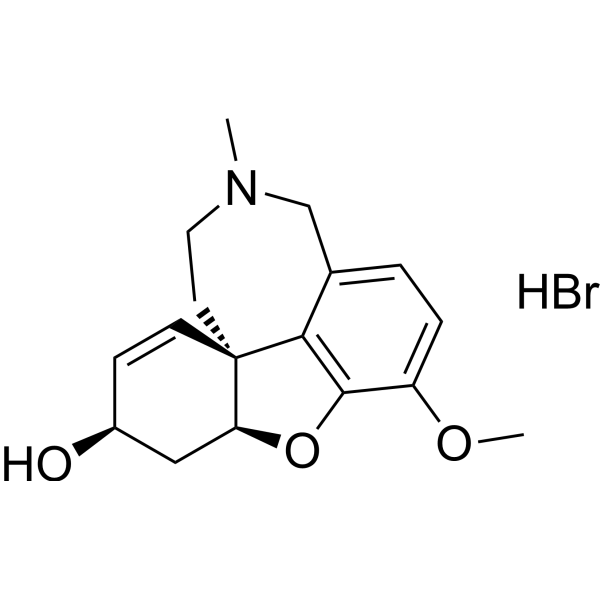
-
- HY-126049
-
|
(S)-(-)-Oxiracetam; (S)-ISF2522
|
Apoptosis
|
Neurological Disease
|
|
(S)-oxiracetam (S-ORC) is an inhibitor targeting apoptosis. S-ORC reduces brain infarct size and lessens neurological dysfunction in middle cerebral artery occlusion/reperfusion (MCAO/R) models. S-ORC prevents neuronal apoptosis via activating PI3K/Akt/GSK3β signaling pathway via α7 nAChR after ischemic stroke. S-ORC can prevent neuronal death after ischemic stroke .
|
-

-
- HY-P5850
-
|
|
nAChR
|
Neurological Disease
|
|
α-Conotoxin Bt1.8 is a potent α6/α3β2β3 and α3β2 nAChRs inhibitor with IC50s of 2.1 nM and 9.4 nM against rat α6/α3β2β3 and α3β2, respectively .
|
-

-
- HY-15310
-
Ivermectin
Maximum Cited Publications
18 Publications Verification
MK-933
|
Flavivirus
Dengue virus
Parasite
HIV
Mitophagy
HSV
SARS-CoV
Antibiotic
Autophagy
Bacterial
|
Infection
Cancer
|
|
Ivermectin (MK-933) is a broad-spectrum anti-parasite agent. Ivermectin (MK-933) is a specific inhibitor of Impα/β1-mediated nuclear import and has potent antiviral activity towards both HIV-1 and dengue virus. It is a positive allosteric effector of P2X4 and the α7 neuronal nicotinic acetylcholine receptor (nAChRs). Ivermectin also inhibits bovine herpesvirus1 (BoHV-1) replication and inhibits BoHV-1 DNA polymerase nuclear import . Ivermectin is a candidate therapeutic against SARS-CoV-2/COVID-19 .
|
-
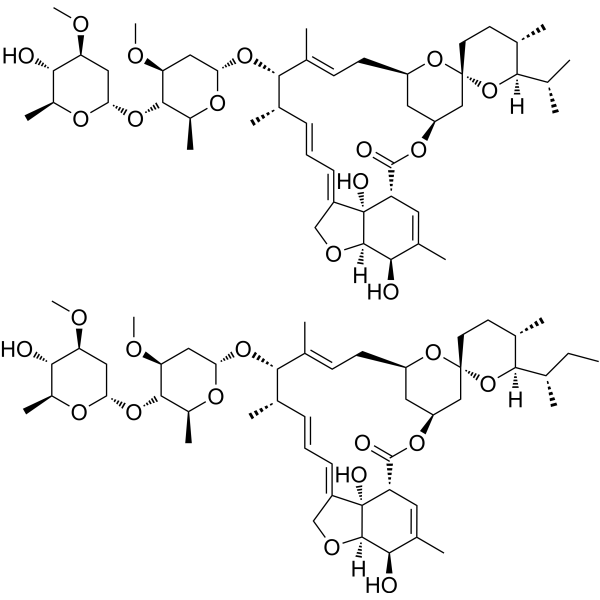
-
-
HY-L062
-
|
|
1785 compounds
|
|
Neurotransmitter (NT) receptors, also known as neuroreceptors, are a broadly diverse group of membrane proteins that bind neurotransmitters for neuronal signaling. There are two major types of neurotransmitter receptors: ionotropic and metabotropic. Ionotropic receptors are ligand-gated ion channels, meaning that the receptor protein includes both a neurotransmitter binding site and an ion channel. The binding of a neurotransmitter molecule (the ligand) to the binding site induces a conformational change in the receptor structure, which opens, or gates, the ion channel. The term “metabotropic receptors” is typically used to refer to transmembrane G-protein-coupled receptors. Metabotropic receptors trigger second messenger-mediated effects within cells after neurotransmitter binding.
In some neurological diseases, the neurotransmitter receptor itself appears to be the target of the disease process. Many neuroactive drugs act by modifying neurotransmitter receptors. A better understanding of neurotransmitter receptor changes in disease may lead to improvements in therapy.
MCE designs a unique collection of 1785 compounds targeting a variety of neurotransmitter receptors. MCE Neurotransmitter Receptor Compound Library is a useful tool for neurological diseases drug discovery.
|
| Cat. No. |
Product Name |
Target |
Research Area |
-
- HY-P1271
-
|
|
nAChR
|
Cardiovascular Disease
|
|
Catestatin is a 21-amino acid residue, cationic and hydrophobic peptide. Catestatin is an endogenous peptide that regulates cardiac function and blood pressure . Catestatin is a non-competitive nicotinic antagonist acting through nicotinic acetylcholine receptors (nAChRs) to inhibit catecholamine release .
|
-
- HY-P5823
-
|
|
nAChR
|
Neurological Disease
|
|
Azemiopsin is a potent nicotinic acetylcholine receptor (nAChR) inhibitor with IC50s of 0.18 μM and 22 μM against T. californica nAChR and human α7 nAChR, respectively. Azemiopsin blocks acetylcholine-induced currents in Xenopus oocytes heterologously expressing human muscle-type nAChR .
|
-
- HY-P5844
-
|
|
nAChR
|
Neurological Disease
|
|
α-Conotoxin AuIA is a potent and selective α3β4 n-nAChR inhibitor. α-Conotoxin AuIA is a α-conotoxin that can be isolated from Conus aulicus .
|
-
- HY-P3653
-
|
|
mAChR
nAChR
|
Neurological Disease
|
|
α-Conotoxin M I is a potent and selective inhibitor of mAChR and α1β1γδ nAChR, but has no effect on nicotine-stimulated dopamine release. α-Conotoxins are small, disulfide-rich peptides that competitively inhibit muscle and neuronal nicotinic AChRs .
|
-
- HY-P5147
-
|
|
nAChR
|
Neurological Disease
|
|
α-Conotoxin GID is a paralytic peptide neurotoxin and a selective antagonist of nAChR, with IC50s of 5 nM (α7), 3 nM (α3β2), 150 nM (α4β2), respectively. α-Conotoxin GID is small disulfide-rich peptide, with potential to inhibit chronic pain. α-Conotoxin GID contains a C-terminal carboxylate, thus substitution with a C-terminal carboxamide results in loss of α4β2 nAChR. α-Conotoxin GID can be isolated from the Conus species .
|
-
- HY-P1271A
-
|
|
nAChR
|
Cardiovascular Disease
|
|
Catestatin TFA is a 21-amino acid residue, cationic and hydrophobic peptide. Catestatin TFA is an endogenous peptide that regulates cardiac function and blood pressure . Catestatin TFA is a non-competitive nicotinic antagonist acting through nicotinic acetylcholine receptors (nAChRs) to inhibit catecholamine release .
|
-
- HY-125777A
-
|
|
nAChR
|
Neurological Disease
|
|
α-Conotoxin Vc1.1 TFA is a disulfide-bonded peptide isolated from Conus victoriae and is a selective nAChR antagonist. α-Conotoxin Vc1.1 TFA inhibits α3α5β2, α3β2 and α3β4 with IC50s of 7.2 μM, 7.3 μM and 4.2 μM, respectively, and has less inhibitory effect on other nAChR subtypes. α-Conotoxin Vc1.1 TFA has the potential for neuropathic pain reserach .
|
-
- HY-P5146
-
-
- HY-P1266
-
|
|
nAChR
|
Neurological Disease
|
|
α-Conotoxin EI is a selective nicotinic acetylcholine α1β1γδ receptor (nAChR) antagonist (IC50=187 nM) and an α3β4 receptor inhibitor. α-Conotoxin EI can block muscle and ganglionic receptors .
|
-
- HY-P5850
-
|
|
nAChR
|
Neurological Disease
|
|
α-Conotoxin Bt1.8 is a potent α6/α3β2β3 and α3β2 nAChRs inhibitor with IC50s of 2.1 nM and 9.4 nM against rat α6/α3β2β3 and α3β2, respectively .
|
| Cat. No. |
Product Name |
Category |
Target |
Chemical Structure |
| Cat. No. |
Product Name |
Chemical Structure |
-
- HY-B0282S
-
|
|
|
Acetylcholine-d4 (chloride) is the deuterium labeled Acetylcholine chloride. Acetylcholine chloride (ACh chloride), a neurotransmitter, is a potent cholinergic agonist. Acetylcholine chloride is a modulator of the activity of dopaminergic (DAergic) neurons through the stimulation of nicotinic acetylcholine receptors (nAChRs)[1][2]. Acetylcholine chloride inhibits p53 mutant peptide aggregation in vitro[5].
|
-

-
- HY-B0282S1
-
|
|
|
Acetylcholine-d9 (chloride) is the deuterium labeled Acetylcholine chloride. Acetylcholine chloride (ACh chloride), a neurotransmitter, is a potent cholinergic agonist. Acetylcholine chloride is a modulator of the activity of dopaminergic (DAergic) neurons through the stimulation of nicotinic acetylcholine receptors (nAChRs)[1][2]. Acetylcholine chloride inhibits p53 mutant peptide aggregation in vitro[5].
|
-

-
- HY-A0009S
-
|
|
|
Galanthamine-d3 (hydrobromide) is deuterium labeled Galanthamine (hydrobromide). Galanthamine hydrobromide (Galantamine hydrobromide) is a selective, reversible, competitive, alkaloid AChE inhibitor, with an IC50 of 0.35 µM. Galanthamine hydrobromide is a potent allosteric potentiating ligand (APL) of human α3β4, α4β2, α6β4 nicotinic receptors ( nAChRs). Galanthamine hydrobromide is developed for the research of Alzheimer's disease (AD)[1][2][3].
|
-

Your information is safe with us. * Required Fields.
Inquiry Information
- Product Name:
- Cat. No.:
- Quantity:
- MCE Japan Authorized Agent:













































